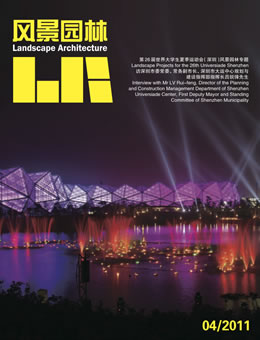Introduction
撰文 (美国)乔-布莱恩-布雷
Text by Jon Bryan BURLEY (US)
翻译 杨云峰
Translation by YANG Yun-feng
很高兴能有机会在这期和今后几期向中国读者介绍关于欧美风景园林研究的一系列文章。文章多由北美和欧洲资深学者执笔。每期专栏文章由前言、作者介绍自己如何开始设计研究并将其融入职业生涯,及正文组成。栏目邀稿的文章主要关于风景园林的研究项目,涉及人文、地理、自然科学、社会科学等与规划设计有直接关系的领域。
非常感谢《风景园林》杂志能给予这么好的机会让欧美学者分享他们的从业经历。《风景园林》杂志社的编辑将自述性的前言和正文同时刊登,这种组稿方式非常新颖,可见杂志在国内外学者间的交流颇下苦心。这种创新性的栏目设置有助于传播对规划设计实践具有学术价值的科学研究。
介绍这些研究成果并非想证明作者有多高明,而是希望在中国同行进行设计研究时提供借鉴。实际上,西方学界的很多研究方法的起源来自中国、埃及等东方国家。通过这个专栏,我们将自己对自然环境、园林设计的深入研究整理成文,与中国同行交流。或者可以这么说,没有中国秦汉、唐宋时期的东西文化交流,西方的研究活动可能会经过更多坎坷。
从各个方面看,专栏的参与者都很乐意齐心协力,分享他们从业经历的心得。杨云峰博士2010年访问密歇根州立大学,为风景园林系学生开展讲座,并与我合作研究湿地生物栖息地生态模型相关课题。我到访过35个国家,并在瑞典、英国、法国、德国、葡萄牙、爱沙尼亚、意大利、韩国、尼泊尔、加拿大、美国、中国举行过讲座。我曾7次到访中国,并于上海交通大学、浙江农林大学、仲恺农业工程学院、北京大学、北京林业大学、同济大学、香港大学、南京林业大学举办过讲座,并与南京林业大学风景园林学院王浩教授于2007年代表各自所在高校签订合作协议,为两校师生交流互访提供便利。这也是中国高校积极拓展对外交流的一个缩影。几乎每所高校都希望在开展广泛的国际合作,为教师和学生深造,开拓视野提供平台。
中国风景园林师在世界各地进行着设计实践和研究,同时来自北美、欧洲、澳大利亚等地的从业者也为中国本土的行业发展发挥着重要作用。21世纪,国际间的行业合作会更加频繁,中国将迎来行业发展的繁荣时期。希望读者对这个专栏感兴趣,并对你们的学术研究有所帮助。
We are very pleased to share and present to you in this issue and forthcoming issues, examples of landscape architectural research from researchers outside of the People’s Republic of China, primarily from North America and Europe. Our plan is to present a peer reviewed research paper for the readership, plus a preface where a personal touch is given that illustrates the character of the investigator, how they began their research, and how the research integrates into their professional life. The forthcoming articles will feature research from a broad array of landscape architectural research projects including studies in the humanities, geography, natural science, and social science that have a direct relationship to planning and design.
We are extremely grateful to the editors of Landscape Architecture to allow publication space to share these personal journeys of our colleagues from around the world. This combination of a lengthy preface along with the research article is an extremely novel combination illuminating manuscripts and demonstrating how the editors of Landscape Architecture are on the “cutting-edge” of planning and design research communication. They are creating a new and more thoughtful forum for the transmission of scholarly planning and design investigations.
None of these studies are meant to support the idea that researchers from other parts of the world are superior; but rather to infuse examples for Chinese scholars to consider as they develop their own plans for research. In fact, one can connect the origins of Western research methods with influences from China and also in the African continent via Egypt. Through the presentation of these articles, the activity of scholarship and investigating the environment comes full circle and returns to China. Possibly without the influences of China and contacts with China during the Han, Tang, and Song dynasties, Western research activities may not have developed so successfully.
In many ways, we are in an age of global academic harmony, where researchers from around the world share their findings and work cooperatively together. Dr. Yang Yun-feng has been a visiting professor in the United States of American at Michigan State University, giving lectures and collaboratively working upon research investigations with me. I have travelled to 35 countries and has lectured in Sweden, United Kingdom, France, Germany, Portugal, Estonia, Italy, South Korea, Nepal, Canada, the United States of America, and the People’s Republic of China. I have spoken at Jiao Tong University in Shanghai, Zhejiang A&F University, Zhongkai University of Agriculture and Engineering, Beijing University, Beijing Forestry University, Tongji University , the University of Hong Kong, and Nanjing Forestry University. Dr. Wang Hao from Nanjing Forestry University and I have been working closely together to share faculty experiences and improve the quality of landscape architectural research education at their respective institutions. This cooperation is an example of the type of exchanges that is occurring at many major Chinese universities and other universities around the world. For example, the landscape architecture faculty of Nanjing Forestry University also have connections with the University of Georgia, Harvard University, and with a university in Sweden. The landscape architecture faculty at Michigan State University have working relationships with Leeds Metropolitan University in the United Kingdom, Agro-campus Ouest, Angers, France, Universidade do Algarve, Faro, Portugal, Swedish University of Agricultural Sciences (SLU Alnarp), Sweden, Dortmund University, Germany, University of Naples Frederico II, Napoli, Italy, Nanjing Forestry University, and Beijing Forestry University. Each and every major university is developing a network across the globe, sharing faculty, conducting international research, and giving students international education.
Chinese landscape architects plan and design projects around the world and conduct research across the planet. In China, North Americans, Europeans, Australians, and others participate in important efforts within China. The beginning of the millennium has been a period of intensified international cooperation and is reflective of China entering another industrious period of intellectual success and prosperity.
We hope this special set of presentations and papers will be of interest to you and provide meaningful insight into your own academic agenda.
作者简介:
乔-布莱恩-布雷/博士/美国密歇根州立大学规划设计建设学院风景园林系教授/美国风景园林师协会资深会员
Biography:
Dr. Jon Bryan BURLEY is a professor of Landscape Architecture at the School of Planning Design and Construction, College of Social Science and College of Agriculture and Natural Resources, Michigan State University. He is also a Fellow of American Society of Landscape Architects.
 《风景园林》2011第4期导读
《风景园林》2011第4期导读
Leave a Reply